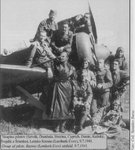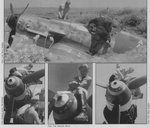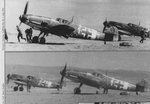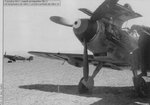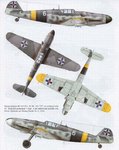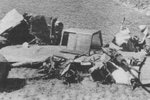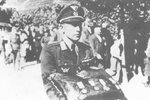imalko
Chief Master Sergeant
Authors : Stanislav Bursa and Jozef Anďal
Translated from Slovak language by imalko
By the number of aircrafts available Slovak Air Arms (Slovenske Vzdušné zbrane or SVZ) was one of the smallest air forces in World War Two. Already in first days of its existence, in March 1939, its members were forced to defend their country from Hungarian aggression. Then came a moment of false glory with participation in German attack on Poland in September 1939. Most controversial and at the same time most successful period in short history of the SVZ was deployment of several Slovak squadrons on the Eastern front during 1941-1943. The joining of the majority of members of SVZ to the Slovak National Uprising against the Germans in the fall of 1944 marked the simbolic end of its existence. This is the short history of the pilots and airplanes of the most successful and famous unit of the SVZ in World war Two - 13th fighter squadron or (in Slovak language) Letka 13.
Letka 13 was formally established on 31st of January 1940 and equipped with Avia B.534 biplane fighters. In July 1941, the squadron was sent to its first tour of duty on the Eastern front as part of larger contingent of air and ground units of Slovakian army. Succesfull deployment of outdated biplanes B.534 on the front was possible only due to the absolute air suppremacy of the Luftwaffe. However, with comming of the winter there were no doubts that this planes are not suitable for deployment in harsh front conditions. Therefore Letka 13 was returned to Slovakia without any confirmed air victory.
If unit was to be deployed on the front again, reequipment with more modern fighter planes was essential.
Therefore Slovakia made agreement with Germany on purchasing Bf 109 fighter airplanes and training of Slovakian pilots in Luftwaffe's training centers. In February 1942 men of the Letka 13 arrived to Gröve in Denmark for training on Bf 109 fighters. In July first 12 examples of Bf 109E were delivered to Slovakia. These were old and many times repaired aircrafts, which saw service with the Luftwaffe in France and North Africa.
Since the Germans demanded immediate deployment of Slovak squadron on the front, as soon as in October 1942 first group of 14 pilots and associate ground personnel arrived on the Eastern front for their second tour of duty. Slovak squadron was assigned to the II Gruppe Jagdgeschwader 52 becoming officialy 13.(Slowak)/JG 52. Slovak pilots were engaged in air fighting over the southern part of the Eastern front - over Caucasus and Cuban areas. Messerschmitts Bf 109E with which squadron was equipped were quickly loosing their battle effectivnes, they were old and immediate replacement with new aircrafts was needed. In that situation the Germans "loaned" to Letka 13 some Bf 109Fs and later also Messerschmitts Bf 109G-2 and G-4. First group of Slovak airmen remained on the front up until July 1943. Althogh exhausted with continuous combat activity, they were very succesfull. During the period October 1942-July 1943, pilots of Letka 13 flew 1504 combat sorties, engaged in 206 air battles and achieved 154 comfirmed and 16 uncomfirmed air victories. Most succesfull fighter pilots in history of Slovak Air Force became: Ján Režňák (32 air victories), Izidor Kovárik (28 victories) i Ján Gerthofer (23 air victories).
First group of Slovak pilots on the front was replaced by the second group in July 1943. Upon their return to Slovakia, some members of the first group of front pilots were deployed on mission of home defence against Allied air raids, flying outdated Bf 109Es once more. In the meantime, situation in the East changed considerably in favor of the Soviets and this had negative effect on the battle moral of the second group of Slovak pilots. Germans were on retreat and Letka 13 always remained in the first lines. Slovak pilots began to evade air combat and three pilots with their Bf 109G-4s defected to the Soviets. Desertions began in some Slovak ground units too. In that circumstances German command decided to withdraw Slovak squadron from the front. Before their return to Slovakia, pilots of the second group flew 1100 sorties and shoot down 61 confirmed and 13 uncomfirmed Soviet aircraft. Together, both groups of Slovak pilots managed to shoot down total of 215 Soviet aircrafts in the East.
Upon return of all members of Letka 13 to Slovakia, the squadron was reorganized and deployed as Readiness squadron (Pohotovostna letka) in home defence and equipped with new fighters Messerschmitt Bf 109G-6. However, in this new circumstances Slovak pilots were unwilling to fight the Allies. They flew intercept missions but peacefully tolerated Allied bomber formations which were on their way to targets in Germany or Austria. However, after Allied raid on Slovak capitol city Bratislava and German repeated accusations of cowardice, pilots of Letka 13 attacked American bombers on 26th of June 1944. Result was virtual destruction of Letka 13 at the hand of nummerically superior American fighter escort. In air battles fought on that day three Slovak pilots were killed and one was severelly wounded. Letka lost 7 fighters Bf 109G-6 and, indeed, only one Slovak Messerschmitt returned to its base undamaged. Pilot Gustav Lang managed to shoot down one American bomber B-24, but later was shot down and killed by the Allied P-38 escort fighters. Several other American planes were damaged by the action of Slovak pilots. The ellite fighter squadron of SVZ never again recovered from losses suffered on 26th June and when allout national uprising against the Germans began in late August, this unit ceased to exist. Number of pilots and two Bf 109G-6 of the former 13th squadron participated in the uprising as the part of insurgent so called Combined squadron (Kombinovana letka), achieving some air victories against German and Hungarian aircrafts. After Germans suppresed the uprising some Slovak pilots managed to join 1st Czechoslovak Air Division in Soviet Union.
That is all for now. I hope some of you guys will find this interesting. I will post further informations on this subject, most notably about top scoring Slovak fighter pilots. But since all my materials are in Slovak language it will take some time to translate them to English.
This text and fallowing pictures are from HT model Špecial, which had several publications published on this subject.
All comments, opinios, questions... or maybe some aditional informations that I might have overlooked are welcomed.
Here are some pictures: Aircraft and men of Letka 13, first tour of duty on the Eastern front, summer 1941
Translated from Slovak language by imalko
By the number of aircrafts available Slovak Air Arms (Slovenske Vzdušné zbrane or SVZ) was one of the smallest air forces in World War Two. Already in first days of its existence, in March 1939, its members were forced to defend their country from Hungarian aggression. Then came a moment of false glory with participation in German attack on Poland in September 1939. Most controversial and at the same time most successful period in short history of the SVZ was deployment of several Slovak squadrons on the Eastern front during 1941-1943. The joining of the majority of members of SVZ to the Slovak National Uprising against the Germans in the fall of 1944 marked the simbolic end of its existence. This is the short history of the pilots and airplanes of the most successful and famous unit of the SVZ in World war Two - 13th fighter squadron or (in Slovak language) Letka 13.
Letka 13 was formally established on 31st of January 1940 and equipped with Avia B.534 biplane fighters. In July 1941, the squadron was sent to its first tour of duty on the Eastern front as part of larger contingent of air and ground units of Slovakian army. Succesfull deployment of outdated biplanes B.534 on the front was possible only due to the absolute air suppremacy of the Luftwaffe. However, with comming of the winter there were no doubts that this planes are not suitable for deployment in harsh front conditions. Therefore Letka 13 was returned to Slovakia without any confirmed air victory.
If unit was to be deployed on the front again, reequipment with more modern fighter planes was essential.
Therefore Slovakia made agreement with Germany on purchasing Bf 109 fighter airplanes and training of Slovakian pilots in Luftwaffe's training centers. In February 1942 men of the Letka 13 arrived to Gröve in Denmark for training on Bf 109 fighters. In July first 12 examples of Bf 109E were delivered to Slovakia. These were old and many times repaired aircrafts, which saw service with the Luftwaffe in France and North Africa.
Since the Germans demanded immediate deployment of Slovak squadron on the front, as soon as in October 1942 first group of 14 pilots and associate ground personnel arrived on the Eastern front for their second tour of duty. Slovak squadron was assigned to the II Gruppe Jagdgeschwader 52 becoming officialy 13.(Slowak)/JG 52. Slovak pilots were engaged in air fighting over the southern part of the Eastern front - over Caucasus and Cuban areas. Messerschmitts Bf 109E with which squadron was equipped were quickly loosing their battle effectivnes, they were old and immediate replacement with new aircrafts was needed. In that situation the Germans "loaned" to Letka 13 some Bf 109Fs and later also Messerschmitts Bf 109G-2 and G-4. First group of Slovak airmen remained on the front up until July 1943. Althogh exhausted with continuous combat activity, they were very succesfull. During the period October 1942-July 1943, pilots of Letka 13 flew 1504 combat sorties, engaged in 206 air battles and achieved 154 comfirmed and 16 uncomfirmed air victories. Most succesfull fighter pilots in history of Slovak Air Force became: Ján Režňák (32 air victories), Izidor Kovárik (28 victories) i Ján Gerthofer (23 air victories).
First group of Slovak pilots on the front was replaced by the second group in July 1943. Upon their return to Slovakia, some members of the first group of front pilots were deployed on mission of home defence against Allied air raids, flying outdated Bf 109Es once more. In the meantime, situation in the East changed considerably in favor of the Soviets and this had negative effect on the battle moral of the second group of Slovak pilots. Germans were on retreat and Letka 13 always remained in the first lines. Slovak pilots began to evade air combat and three pilots with their Bf 109G-4s defected to the Soviets. Desertions began in some Slovak ground units too. In that circumstances German command decided to withdraw Slovak squadron from the front. Before their return to Slovakia, pilots of the second group flew 1100 sorties and shoot down 61 confirmed and 13 uncomfirmed Soviet aircraft. Together, both groups of Slovak pilots managed to shoot down total of 215 Soviet aircrafts in the East.
Upon return of all members of Letka 13 to Slovakia, the squadron was reorganized and deployed as Readiness squadron (Pohotovostna letka) in home defence and equipped with new fighters Messerschmitt Bf 109G-6. However, in this new circumstances Slovak pilots were unwilling to fight the Allies. They flew intercept missions but peacefully tolerated Allied bomber formations which were on their way to targets in Germany or Austria. However, after Allied raid on Slovak capitol city Bratislava and German repeated accusations of cowardice, pilots of Letka 13 attacked American bombers on 26th of June 1944. Result was virtual destruction of Letka 13 at the hand of nummerically superior American fighter escort. In air battles fought on that day three Slovak pilots were killed and one was severelly wounded. Letka lost 7 fighters Bf 109G-6 and, indeed, only one Slovak Messerschmitt returned to its base undamaged. Pilot Gustav Lang managed to shoot down one American bomber B-24, but later was shot down and killed by the Allied P-38 escort fighters. Several other American planes were damaged by the action of Slovak pilots. The ellite fighter squadron of SVZ never again recovered from losses suffered on 26th June and when allout national uprising against the Germans began in late August, this unit ceased to exist. Number of pilots and two Bf 109G-6 of the former 13th squadron participated in the uprising as the part of insurgent so called Combined squadron (Kombinovana letka), achieving some air victories against German and Hungarian aircrafts. After Germans suppresed the uprising some Slovak pilots managed to join 1st Czechoslovak Air Division in Soviet Union.
That is all for now. I hope some of you guys will find this interesting. I will post further informations on this subject, most notably about top scoring Slovak fighter pilots. But since all my materials are in Slovak language it will take some time to translate them to English.
This text and fallowing pictures are from HT model Špecial, which had several publications published on this subject.
All comments, opinios, questions... or maybe some aditional informations that I might have overlooked are welcomed.
Here are some pictures: Aircraft and men of Letka 13, first tour of duty on the Eastern front, summer 1941
Attachments
Last edited:


